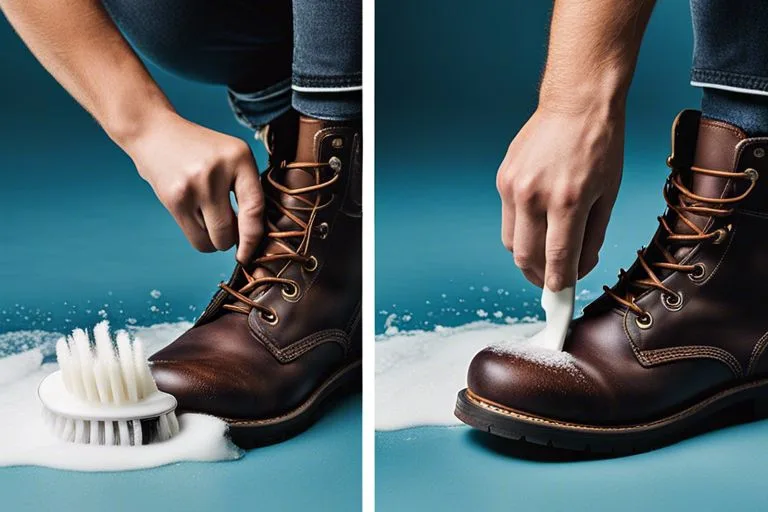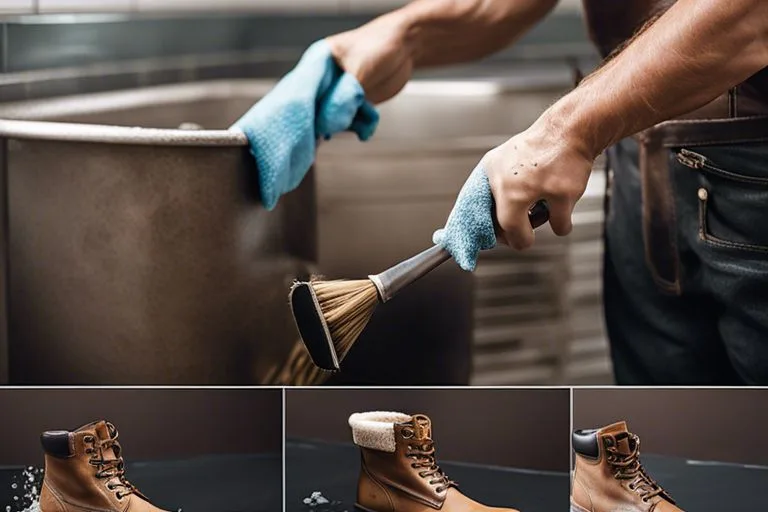When you work in tough conditions, it’s essential to keep your work boots clean and well-maintained to ensure their longevity and your safety. Whether you’re dealing with mud, grease, or other harsh elements, taking proper care of your work boots is crucial for their performance and your comfort. In this guide, you’ll learn the best techniques for cleaning your work boots so that they continue to protect your feet and provide the support you need.
Cleaning your work boots regularly not only prolongs their lifespan but also helps you maintain good traction and stability, reducing the risk of slips and falls. Additionally, by keeping your boots clean and well-maintained, you can prevent the growth of bacteria and fungi, which can lead to unpleasant odors and foot infections. By following the steps outlined in this article, you’ll be able to extend the life of your work boots and ensure that they continue to provide you with the protection and support you need on the job.
Key Takeaways:
- Regular cleaning: Regularly cleaning work boots can help prevent the buildup of dirt and grime, extending the lifespan of the boots and ensuring they remain in good condition.
- Use the right tools: Utilize appropriate tools such as a brush, mild detergent, and water to effectively clean work boots without damaging them.
- Drying and conditioning: After cleaning, it’s important to properly dry and condition work boots to ensure they remain in good shape and are ready for future use.
Preparing to Clean Your Work Boots
Even the toughest work boots need regular cleaning to maintain their durability and performance. Before you start cleaning, it’s important to prepare yourself and gather the necessary supplies. Additionally, identifying your boot material will help you choose the best cleaning method. Here’s how to get started.
Gathering Necessary Supplies
First things first, you’ll need to gather the necessary supplies for cleaning your work boots. This includes a stiff-bristled brush, mild soap or boot cleaner, a soft cloth or sponge, and a waterproofing product if your boots are not already waterproof. Additionally, you may want to invest in a specialized boot cleaning kit, which typically includes everything you need to keep your boots in top shape. You can find a detailed guide on how to clean smelly work boots here.
Identifying Your Boot Material
Before you start the cleaning process, it’s important to identify the material of your work boots. Whether they’re made of leather, suede, rubber, or synthetic materials, each type requires a different cleaning approach. Leather boots, for example, need to be conditioned and polished, while suede boots may require special brushes and cleaners. If you’re not sure what material your boots are made of, check the label or reach out to the manufacturer for guidance. Knowing your boot material is crucial for determining the cleaning method that will be most effective and safe for your boots.

General Cleaning Techniques
Assuming you want to keep your work boots in top condition, it’s important to have a general cleaning routine in place. You can find detailed instructions in this How To Clean your Work Boots: A Simple Guide.
Dusting and Brushing Off Dirt
Before deep cleaning your work boots, it’s essential to remove any loose dirt and debris that may be stuck to the surface. Use a soft brush or a damp cloth to gently brush off the dirt from the boots. You can also use a toothbrush to reach small crevices and seams.
Removing Mud and Grime
If your work boots have hardened mud or grime, you can use a mixture of mild soap and warm water to gently scrub the affected areas. Use a soft-bristled brush to work the solution into the boots, and then wipe away the soap residue with a clean, damp cloth. Avoid using harsh chemicals or abrasive cleaners, as they can damage the materials of your boots.
Tips for Drying Work Boots
After cleaning your work boots, it’s essential to dry them properly to prevent mold and mildew from forming. You can stuff your boots with crumpled paper or a boot shaper to help them retain their shape as they dry. Place them in a well-ventilated area at room temperature, away from direct heat sources like radiators or sunlight, which can cause the leather to crack. Avoid using a hairdryer or any other direct heat source to speed up the drying process.
- Remove the insoles and laces from your work boots to promote airflow.
- Allow your boots to air dry naturally, which may take up to 24 hours depending on the climate and materials of your boots.
- Check the manufacturer’s recommendations for specific care instructions for your work boots.
After your work boots are completely dry, you can reinsert the insoles and relace them, and they will be ready to wear again.
Deep Cleaning Methods
Unlike regular cleaning, deep cleaning methods are more intensive and are meant to remove ingrained dirt and grime from your work boots. Depending on the material of your boots, you can use different methods for deep cleaning to ensure they stay in top condition for as long as possible. In this section, we will cover deep cleaning methods for both leather and synthetic material work boots.
Cleaning Leather Boots
If your work boots are made of leather, deep cleaning is essential to maintain their durability and appearance. Start by removing the laces and any dirt or debris from the surface of your boots. Use a soft-bristled brush to gently scrub away any remaining dirt or stains. Next, apply a small amount of leather cleaner to a clean cloth and gently rub it into the surface of your boots, focusing on any particularly dirty areas. Once the boots are clean, wipe off any excess cleaner with a damp cloth and allow them to air dry completely. Finish off by applying a leather conditioner to keep the leather soft and supple, and to prevent it from drying out and cracking. This deep cleaning process will help to maintain the quality of your leather work boots, ensuring that they remain in good condition for a long time.
Cleaning Synthetic Materials
If your work boots are made of synthetic materials, such as rubber or nylon, deep cleaning is also important to remove embedded dirt and grime. Start by removing any excess dirt and debris from the surface of your boots using a soft-bristled brush. To deep clean synthetic material work boots, create a solution of mild detergent and warm water. Use a soft cloth to gently clean the surface of the boots with this solution, paying extra attention to any stubborn stains. Once clean, rinse off any excess detergent with a clean, damp cloth and allow the boots to air dry completely. To maintain the quality of synthetic material work boots, apply a waterproofing spray to protect them from water and other elements. These deep cleaning methods will ensure that your synthetic material work boots remain in top condition, providing you with the necessary protection and support for your work.
Specialized Cleaning Methods
Keep in mind that certain stains and odors on your work boots may require specialized cleaning methods to effectively remove them. Here are some tips for treating oil and grease stains, removing bad odors, and waterproofing your work boots to keep them in top condition.
Treating Oil and Grease Stains
If you’ve accidentally stepped in oil or grease, don’t panic. First, use a dry cloth to blot as much of the oil or grease as possible. Then, sprinkle a generous amount of cornstarch or talcum powder onto the stain and let it sit for a few hours to absorb the remaining oil. Afterward, use a soft-bristled brush to gently scrub off the powder. If the stain persists, you can try using a specialized leather cleaner or saddle soap to remove it. Be sure to follow the product instructions carefully to avoid damaging the leather.
Removing Bad Odors
After a long day at work, your boots may start to develop unpleasant odors. To combat this, start by removing the insoles and allowing them to air out. Next, sprinkle baking soda inside the boots and let them sit overnight to absorb any lingering odors. In the morning, simply shake out the excess baking soda and replace the insoles. For stubborn odors, you can also use a mixture of vinegar and water to wipe down the inside of the boots, but be sure to allow them to dry completely before wearing them again.
Waterproofing Your Work Boots
To protect your work boots from water damage, it’s essential to waterproof them regularly. You can use a quality leather waterproofing spray or wax to create a protective barrier against moisture. Before applying the waterproofing treatment, make sure to clean the boots thoroughly and allow them to dry completely. Then, evenly spray or rub the waterproofing product onto the surface of the boots, paying special attention to the seams and stitching. This will help prevent water from seeping into the leather and causing damage.
Maintenance and Care
Not only is it important to clean your work boots, but maintaining and caring for them properly will also ensure their longevity and performance. By following a regular cleaning schedule, proper storage practices, and avoiding common mistakes, you can keep your work boots in top condition for years to come.
Regular Cleaning Schedule
Establishing a regular cleaning schedule for your work boots is crucial to their upkeep. After each use, wipe off any dirt, mud, or debris with a soft brush or damp cloth. This will prevent the buildup of grime and prolong the lifespan of your boots. For more thorough cleaning, use a mild soap or boot cleaner to remove stubborn stains. Allow your boots to air dry completely before wearing them again, as wearing damp boots can lead to mold and mildew growth, as well as unpleasant odors.
Proper Storage Practices
When you’re not wearing your work boots, proper storage is key to maintaining their shape and condition. Avoid storing them in damp or humid areas, as this can lead to mold and mildew growth. Instead, keep your boots in a well-ventilated area, away from direct sunlight and extreme temperatures. Stuffing your boots with boot trees or newspaper can help them maintain their shape and absorb any lingering moisture. Additionally, consider investing in a boot storage rack or shelf to keep them off the ground and organized.
Avoiding Common Mistakes
There are a few common mistakes that many people make when it comes to caring for their work boots. Avoid using harsh chemicals or cleaners, as these can damage the leather or other materials. Stick to mild soap and water, or products specifically designed for cleaning boots. Additionally, do not expose your boots to direct heat sources such as radiators or open flames, as this can cause the leather to dry out and crack. Finally, do not neglect regular conditioning and waterproofing treatments, as these help to keep your boots supple and protected from the elements.
Troubleshooting Common Issues
Now that you know how to clean work boots effectively, let’s address some common issues that may arise during the cleaning process. It’s important to be able to identify and troubleshoot these issues to ensure that your work boots stay in good condition for as long as possible.
Discoloration and Fading
If you notice that your work boots are starting to show signs of discoloration and fading, it’s important to take action to prevent further damage. This can occur due to prolonged exposure to sunlight, harsh cleaning agents, or simply as a result of normal wear and tear. To address this issue, you can try using a leather conditioner or protectant to restore the color and prevent further fading. Additionally, make sure to store your work boots in a cool, dry place away from direct sunlight when not in use to minimize the risk of discoloration.
Repairing Minor Damage
Minor damage such as scuffs, scratches, or small tears can occur over time, especially if you use your work boots regularly. While these issues may seem insignificant, it’s important to address them promptly to prevent them from worsening and affecting the overall integrity of your boots. You can use a high-quality leather repair cream or polish to conceal minor imperfections and restore the appearance of your work boots. Additionally, consider investing in a good quality waterproofing spray to protect your boots from further damage and extend their lifespan.
 1. Remove excess dirt and debris.
1. Remove excess dirt and debris.
2. Use a soft brush or cloth.
3. Use a mild soap and warm water.
4. Dry boots thoroughly, away from direct heat.
5. Condition leather after cleaning.
6. Store boots in a cool, dry place.
Conclusion
On the whole, keeping your work boots clean is essential for their longevity and performance. By following the steps outlined in this guide, you can ensure that your boots remain in top condition and continue to provide the support and protection you need on the job. Regular cleaning and maintenance will also prevent any dirt, grime, or moisture from compromising the structural integrity of your boots, ultimately extending their lifespan and saving you money in the long run.
Remember to clean your work boots after each use and to allow them to fully dry before wearing them again. Additionally, investing in a high-quality boot cleaner and conditioner will further enhance the effectiveness of your cleaning routine. By taking these simple steps, you can keep your work boots looking and performing their best for years to come.
Work Boot Cleaning FAQ
Q: Why is it important to clean work boots regularly?
A: Regular cleaning of work boots removes dirt and debris that can cause premature wear and tear. It also helps prevent the growth of mold and bacteria, maintaining a healthier and more durable boot.
Q: What is the best way to clean work boots?
A: The best way to clean work boots is to remove the laces and insoles, then use a brush and mild soap or specialized boot cleaner to gently scrub away dirt and stains. Rinse with water and allow to air dry completely before re-lacing.
Q: Can I use a washing machine to clean my work boots?
A: It is not recommended to clean work boots in a washing machine, as this can damage the materials and construction of the boots. Hand cleaning with a brush and mild soap is the preferred method for maintaining the integrity of the boots.
Q: How often should I clean my work boots?
A: Work boots should be cleaned as often as needed, depending on the level of dirt and grime they are exposed to. In general, a thorough cleaning every few weeks or after particularly messy work is a good practice.
Q: Are there any special considerations for cleaning leather work boots?
A: Leather work boots should be cleaned with a specialized leather cleaner and conditioner, following the manufacturer’s recommendations. It is important to avoid using harsh chemicals or excessive water, as these can damage the leather. Regular conditioning will also help maintain the suppleness and water resistance of the leather.

